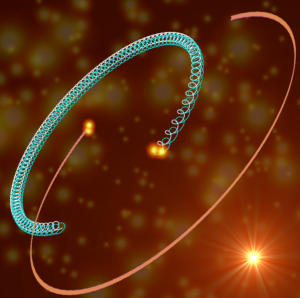
20 May SALT Contributes to the discovery of a four star system
The Southern African Large Telescope (SALT) and the University of Canterbury’s Mount John Observatory in New Zealand have recently discovered a system of four stars orbiting each other. After initially being identified in 2017 as part of the Gaia-European Southern Observatory (ESO) Survey, careful observations with high-resolution spectrographs have enabled researchers to calculate the orbits of the four stars which consist of a short-period binary orbiting another short-period binary on a longer orbital period.

Trajectories within the quadruple stellar system HD 74438: the two close pairs, having orbital periods of 21 and 4 days, orbit around each other in 6 years. At some point, the two pairs could merge into white dwarfs giving rise to a thermonuclear supernova, as illustrated in the bottom right. (Image Credit: Merle, A)
Stars like to be in company, and unlike our Sun, most of the stars in the Galaxy have one or more stellar companions. Binary stars are now recognized to play a major role in a large range of astrophysical events, such as the 2017 gravitational wave emission detection. In addition, binary stars allow us to derive fundamental stellar parameters like masses, radii and luminosities with better accuracy compared to single stars. They represent the gems on which various astrophysics studies rely.
While binaries have received much attention so far, higher-order stellar systems have remained aside until recently, despite the fact that they show a wide variety of interactions, especially in tight systems. Stellar quadruples only represent a marginal fraction (a few percent) of all multiple systems. The complex evolution of such high-order multiples involves mass transfer and collisions, leading to mergers that are also possible progenitors of thermonuclear supernovae. These supernovae represent standard candles for fixing the Universe distance scale, despite the fact that the evolutionary channel(s) leading to the progenitors of such supernova explosions are still highly debated.
A spectroscopic quadruple (HD 74438) was discovered in 2017 in the Gaia-ESO Survey. The Gaia-ESO Survey is a public spectroscopic survey providing a detailed overview of the stellar content of the Milky Way by characterizing more than 100 000 stars. Subsequent follow-up spectroscopic observations of HD 74438 were obtained with high-resolution spectrographs at the University of Canterbury Mount John Observatory in New Zealand and at the Southern African Large Telescope in South Africa. These observations allowed us to determine that this stellar quadruple is made of 4 gravitationally-bound stars: a short-period binary orbiting another short-period binary on a longer orbital period (2+2 configuration). Its membership in the open cluster IC 2391 makes it the youngest (43 million years) spectroscopic quadruple discovered so far and among the quadruple systems with the shortest outer orbital period (6 years).
Thanks to the spectroscopic analysis it was possible to show that this quadruple system is undergoing dynamic effects on long time scales compared to the orbital periods. Indeed, one of the inner binaries should have evolved into a circular orbit whereas it has an eccentric one. This is explained by the gravitational effect of the distant binary companion which can pump up the eccentricity. State-of-the-art simulations of this system’s future evolution show that such gravitational dynamics can lead to one or multiple collisions and merger events producing white dwarfs with masses just below the Chandrasekhar limit.
A star like our Sun will end its life as a white dwarf, and the mass of white dwarfs cannot go above the so-called Chandrasekhar limit. If it does, as a result of mass transfer or merger events, it does collapse and produces a thermonuclear supernova. Interestingly, 70 to 85% of all thermonuclear supernovae are now suspected to result from the explosion of white dwarfs with sub-Chandrasekhar masses. The evolution of stellar quadruples such as HD 74438 thus represents a new promising channel to form them.
Reference
- Merle, A. S. Hamers, S. Van Eck, A. Jorissen, M. Van der Swaelmen, K. Pollard, R. Smiljanic, D. Pourbaix, Tomaž Zwitter, G. Traven, G. Gilmore, S. Randich, A. Gonneau, A. Hourihane , G. Sacco and C. C. Worley
A spectroscopic quadruple as a possible progenitor of sub-Chandrasekhar type Ia supernovae
Nature Astronomy, Letters https://doi.org/10.1038/s41550-022-01664-5

